Summary Overview
In-Vivo Toxicology Testing Market Overview
The global In-Vivo Toxicology Testing market is steadily expanding, fuelled by rising demand in industries such as pharmaceuticals, biotechnology, chemicals, and environmental research. This market encompasses a diverse set of testing methodologies, including as in-vivo animal studies, cellular tests, and organ-on-chip technologies. Our paper analyses procurement trends in depth, with an emphasis on cost-cutting methods and the growing adoption of digital tools to improve testing procedures and operational efficiencies.
Key future problems in in-vivo toxicity testing include controlling testing costs, guaranteeing regulatory compliance, maintaining data security, and incorporating novel testing methodologies into established research frameworks. The use of sophisticated digital tools and smart sourcing are critical for streamlining testing processes and ensuring long-term market success. As worldwide demand continues, companies are increasingly using cutting-edge technologies and market knowledge to increase testing accuracy, operational performance, and risk mitigation.
Market Size: The global In-Vivo Toxicology Testing market is projected to reach USD 10.5 billion by 2035, growing at a CAGR of approximately 5.67% from 2025 to 2035.
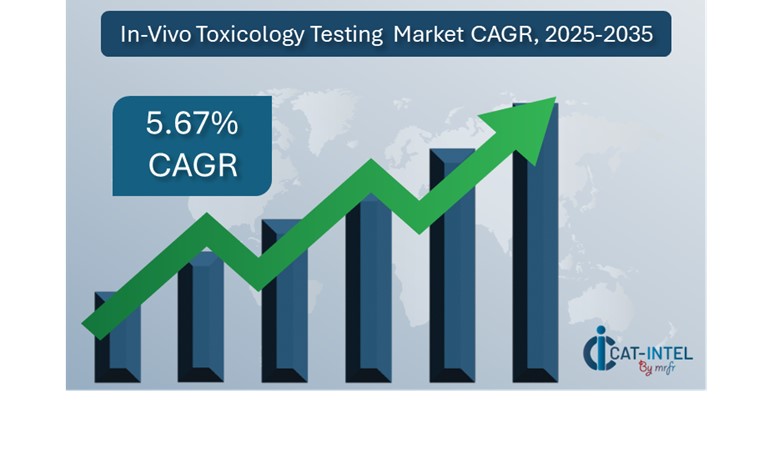
Growth Rate: 5.67%
-
Sector Contributions: Growth in the market is driven by: -
Manufacturing and Research optimization: There is a growing need for real-time data and process integration to speed testing and assure efficiency in toxicological investigations.
-
Pharmaceutical and Biotechnology Advancement: The increased use of in-vivo testing methods for medication development, safety assessment, and regulatory compliance. -
Technological Transformation: AI, machine learning, and automation are being used in toxicity testing to improve predictive modelling, accuracy, and reduce human error. -
Innovations: Non-animal testing models, including organ-on-chip technology, are becoming more cost-effective and ethical, reducing reliance on traditional animal testing methods. -
Investment Initiatives: Pharmaceutical and chemical firms are expanding investing in digital and cloud-based platforms to improve research capabilities.
-
Regional Insights: North America and Europe continue to be major contributors, given to robust regulatory frameworks, excellent research infrastructures, and increasing usage.
Key Trends and Sustainability Outlook:
-
Cloud Integration: The use of cloud-based toxicological testing technologies to improve scalability, data access, and cooperation among research teams. -
Advanced Features: The use of AI, IoT, and blockchain in toxicity testing to improve automation, boost data transparency, and enable real-time decision-making.
-
Focus on Sustainability: Testing procedures are being optimized for sustainability, assuring environmental compliance, reducing waste, and improving animal welfare measures. -
Customization Trends: There is an increasing demand for industry-specific testing solutions targeted to areas such as pharmaceuticals, chemicals, and environmental sciences.
-
Data-Driven Insights: Advanced data analytics in toxicological testing software allows more precise risk evaluations, trend predictions, and efficient resource management.
Growth Drivers:
-
Digital Transformation: Increasing the use of digital technologies in toxicology research to improve productivity, testing procedures, and data management. -
Demand for Process Automation: There is a growing reliance on automated toxicological testing systems to replace manual processes, boost throughput, and lower costs. -
Scalability Requirements: There is a desire for scalable toxicity testing solutions that can expand to meet research needs, providing adaptability and effective incorporation into ongoing investigations. -
Regulatory Compliance: Strict rules in the pharmaceutical and chemical sectors highlight the importance of automated, compliance testing procedures that can ensure consistent data accuracy and regulatory reporting. -
Globalization: As worldwide collaborations expand, there is a greater requirement for in-vivo testing solutions that can handle multi-region compliance while maintaining the same high standards across varied markets.
Overview of Market Intelligence Services for the In-Vivo Toxicology Testing Market:
Recent evaluations of the in-vivo toxicity testing industry have identified important obstacles, including high testing prices and the necessity for specialized testing solutions. Market intelligence reports provide actionable information that assist businesses in identifying cost-saving opportunities, optimizing supplier relationships, and ensuring successful testing program implementation. These insights also help businesses comply with regulatory standards and maintain high-quality testing operations while successfully managing expenditures.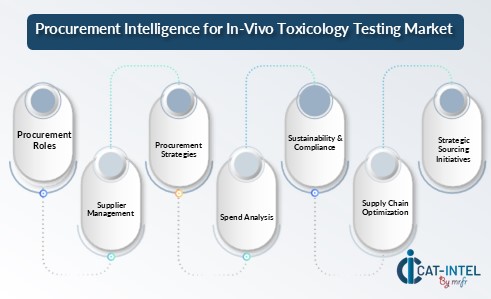
Procurement Intelligence for In-Vivo Toxicology Testing: Category Management and Strategic Sourcing
To remain relevant in the in-vivo toxicity testing industry, firms are simplifying their procurement procedures by analysing spend and evaluating vendor performance. Effective category administration and strategic sourcing are critical for lowering procurement costs while maintaining a consistent supply of dependable testing services and technologies. Businesses may improve their procurement strategy, obtain better deals, and assure they meet their toxicology testing needs efficiently and cost-effectively.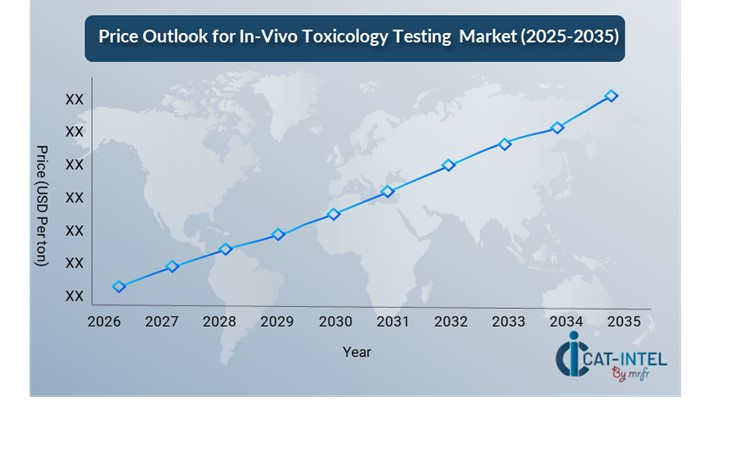
Pricing Outlook for In-Vivo Toxicology Testing: Spend Analysis
The pricing prognosis for in-vivo toxicological testing services is likely to be relatively dynamic, with potential swings caused by a variety of variables. Advancements in testing technology, increased need for alternative testing models (such as organ-on-chip), customized requirements, and regional pricing variances are all important factors to consider. Furthermore, the growing incorporation of AI and machine learning into testing methods, combined with a greater emphasis on data security and legal compliance, is projected to drive up testing service costs.
Graph shows general upward trend pricing for In-Vivo Toxicology Testing and growing demand. However, there may be fluctuations influenced by economic conditions, technological advancements, and competitive dynamic.
Efforts to streamline procurement processes, improve management of suppliers, and implement modular testing solutions are critical for cost control in the in-vivo toxicity testing sector. Leveraging digital tools for market monitoring, analytics-based pricing predictions, and effective contract administration can help to reduce costs even more.
Partnering with reputable testing service providers, negotiating long-term contracts, and investigating flexible pricing methods are all important tactics for effectively managing testing expenses. Despite these hurdles, focusing on scalability, assuring reliable test results, and using innovative testing methods will be critical to sustaining cost-effectiveness and organizational excellence in toxicology research.
Cost Breakdown for In-Vivo Toxicology Testing: Total Cost of Ownership (TCO) and Cost-Saving Opportunities
Testing and Laboratory: (35%)
-
Description: The largest cost component of in-vivo toxicity testing is the laboratory testing itself, which includes expenses for animal models, reagents, consumables, and personnel participating in experimentation.
-
Trend Point: There is a rising emphasis on eliminating animal experimentation and implementing more cost-effective alternatives, such as organ-on-chip technology and AI-powered simulations.
- Regulatory Compliance and Documentation: (XX%)
- Personnel and Expertise: (XX%)
- Animal Care and Housing: (XX%)
Cost-Saving Opportunities: Negotiation Levers and Purchasing Negotiation Strategies
In the in-vivo toxicology testing sector, streamlining procurement processes and using strategic negotiation strategies can result in significant cost savings and improved operational efficiency. Long-term relationships with reputable testing service providers, notably those that use sophisticated or alternative testing methods, might result in more attractive pricing structures and terms, such as volume-driven discounts or bundled service packages. Subscription-based arrangements and multi-year contracts allow you to get reduced rates and prevent price rises over time, providing a cost-effective solution to continuing testing requirements.
Collaborating with testing providers who value innovation, scalability, and the incorporation of cutting-edge technologies like as AI and machine learning for predictive modelling can bring further advantages. These advances can help to increase testing accuracy, reduce the need for repeat testing, and reduce overall operational expenses. Implementing digital procurement technologies such as contract management platforms and usage analytics improves transparency, reduces resource over-provisioning, and maximizes testing service utilization. Diversifying vendor alternatives and using multi-vendor solutions can help to reduce reliance on a single source, eliminate risks like service disruptions, and increase negotiation leverage, resulting in a more robust and cost-effective toxicity testing process.
Supply and Demand Overview for In-Vivo Toxicology Testing: Demand-Supply Dynamics and Buyer Intelligence for Effective Supplier Relationship Management (SRM)
The in-vivo toxicity testing market is expanding steadily, driven by rising research and regulatory needs from industries such as pharmaceuticals, biotechnology, and environmental science. Advanced testing technologies, industry-specific requirements, and worldwide regulatory frameworks all have an impact on supply and demand dynamics.
Demand Factors:
-
Regulatory and Compliance Pressures: The increased requirement to comply with stringent safety standards and regulatory frameworks is driving up demand for in-vivo toxicology testing, particularly in drug development and chemical safety evaluations. -
Technological Advancements: AI, machine learning, and predictive modelling are causing a move toward more accurate and efficient toxicity testing, generating demand for new testing services. -
Industry-Specific Requirements: Industries such as pharmaceuticals and chemicals require unique in-vivo testing solutions tailored to legal requirements, specific testing methodologies, and safety requirements.
-
Integration of Alternative Testing Methods: There is a growing demand for in-vivo testing systems that can work with new alternative testing methods like organ-on-chip technology and in-silico models.
Supply Factors:
-
Technological Advancements: Non-animal testing models, artificial intelligence, and advanced data analytics, which improve the quality and efficiency of in-vivo toxicological testing.
-
Vendor ecosystem: An increasing number of toxicities testing service providers, ranging from boutique businesses to large-scale laboratories, provides buyers with a variety of options while also encouraging competition and providing specialized solutions.
-
Global Economic Factors: Regulatory constraints across locations, as well as exchange rates and labour costs, all have an impact on the availability and pricing of in-vivo toxicological testing services.
-
Scalability and Flexibility: Modern testing services are more modular, allowing suppliers to serve to both major pharmaceutical corporations and small biotech firms.
Regional Demand-Supply Outlook: In-Vivo Toxicology Testing
The Image shows growing demand for In-Vivo Toxicology Testing in both North America and Asia Pacific, with potential price increases and increased Competition.
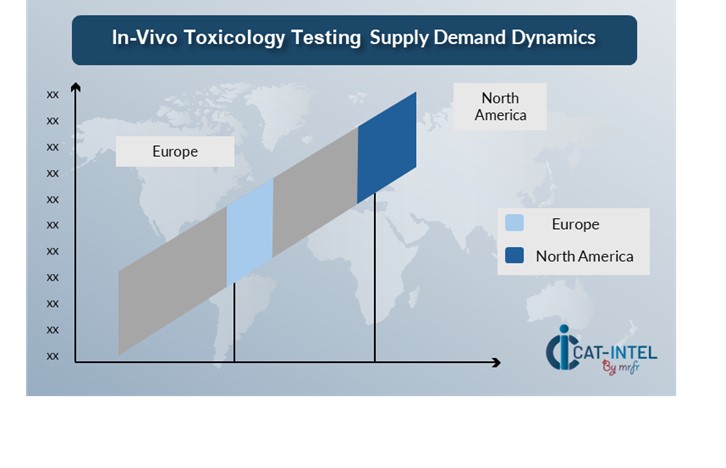
North America: Dominance in the In-Vivo Toxicology Testing Market
North America, particularly the United States, is a dominant force in the global In-Vivo Toxicology Testing market due to several key factors:
-
Strong Pharmaceutical Industry: North America, particularly the United States, is home to many major pharmaceutical and biotechnology companies that rely substantially on in-vivo toxicology testing. -
Advanced Research Capabilities: North America boasts a well-established research infrastructure, including multiple world-class universities, research institutions, and private laboratories specializing in toxicity research.
-
Strict Regulatory Requirements: The region has severe regulatory frameworks established by agencies. Like the United States Food and Drug Administration (FDA) and Health Canada, which demand comprehensive safety and toxicological testing before approving medications, chemicals, and other items.
-
Technical Innovation: North America is a hotbed of technical innovation in testing procedures, including the incorporation of AI, machine learning, and non-animal testing alternatives such as organ-on-chip models.
-
Healthcare and Environmental Safety Standards: North America places a high value on public health, safety, and environmental protection, which has resulted in a surge in toxicity testing for chemical products, pharmaceuticals, and environmental assessments.
North America Remains a key hub In-Vivo Toxicology Testing Price Drivers Innovation and Growth.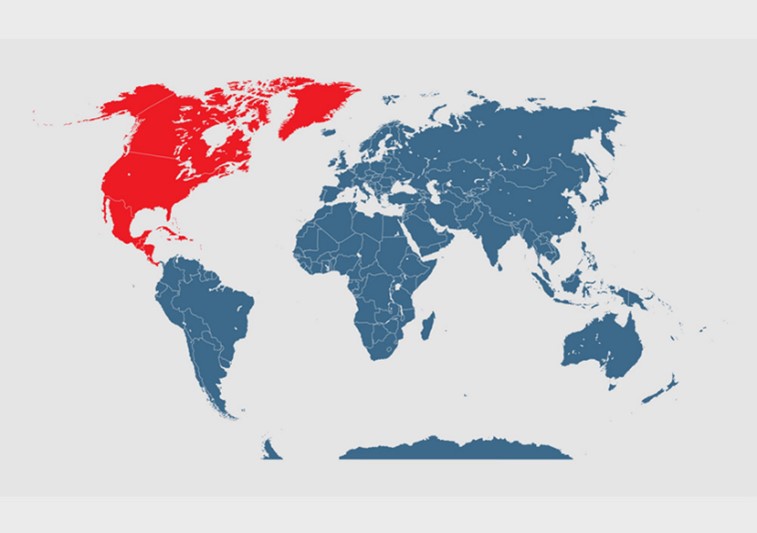
Supplier Landscape: Supplier Negotiations and Strategies
The supplier environment in the in-vivo toxicity testing market is diversified and fiercely competitive, with global leaders and specialized regional providers defining industry trends. These providers have a significant impact on pricing models, testing procedures, and service quality. Well-established contract research organizations (CROs) dominate the market, providing a wide range of in-vivo testing services, while smaller, niche providers specialize in alternative testing methods, specialized toxicology studies, or advanced technologies such as organ-on-chip and AI-driven predictive models.
The in-vivo toxicity testing supplier ecosystem encompasses key technology regions such as North America, Europe, and Asia-Pacific, with both global leaders and creative local businesses meeting industry-specific demands. As regulatory needs and safety requirements grow, suppliers are expanding their service offerings by incorporating cutting-edge technology like as artificial intelligence, machine learning, and organ-on-chip solutions, as well as boosting their services' scalability and adaptability. To fulfil the increased need for precision, cost-efficiency, and ethical testing alternatives, in-vivo toxicity testing vendors are focused on improved integration capabilities, delivering modular solutions that cater to industries like pharmaceuticals, chemicals, and environmental science.
Key Suppliers in the In-Vivo Toxicology Testing Market Include:
- Charles River Laboratories
- Covance (Labcorp Drug Development)
- WuXi AppTec
- Envigo
- Eurofins Scientific
- Pharmaron
- Medpace
- Toxiko
- London
- BASF SE

Key Developments Procurement Category Significant Development
Significant Development |
Description |
Market Growth |
The in-vivo toxicity testing market is expanding rapidly due to increased demand from industries such as pharmaceuticals, biotechnology, and chemicals, as businesses prioritize regulatory compliance, product safety, and environmental sustainability. |
Cloud Adoption |
The desire to speed testing processes, increase accuracy, and satisfy tougher regulatory standards is increasing demand for advanced testing solutions, particularly in emerging economies with changing regulatory frameworks. |
Product Innovation |
As firms strive to improve product safety, in-vivo testing providers are increasingly combining machine learning, AI, and real-time data processing into their solutions, resulting in faster and more accurate findings. |
Technological Advancements |
Toxicology testing companies are increasing their capabilities by adding specialized innovations, including customisable in-vivo testing modules and the integration of modern technology to respond to the individual needs of each sector, such as for healthcare or environmental safety for chemical companies. |
Global Trade Dynamics |
Multinational corporations with complicated supply chains and research requirements are increasingly looking for testing solutions that can adapt changing regulatory landscapes and ensure product safety across several markets. |
Customization Trends |
The demand for customization is driving toxicological testing providers to deliver increasingly specific services, such as custom study designs, specialized testing methods, and interaction with third-party tools or technologies. |
|
In-Vivo Toxicology Testing Attribute/Metric |
Details |
Market Sizing |
The global In-Vivo Toxicology Testing market is projected to reach USD 10.5 billion by 2035, growing at a CAGR of approximately 5.67% from 2025 to 2035. |
In-Vivo Toxicology Testing Technology Adoption Rate |
Around 60% of pharmaceutical and biotechnology companies worldwide have implemented in-vivo toxicology testing solutions, with a growing interest in novel options such as organ-on-chip technology and AI-powered predictive models. |
Top In-Vivo Toxicology Testing Industry Strategies for 2025 |
Key methods include incorporating AI and machine learning for predictive toxicity evaluations, decreasing animal testing through new technologies, enhancing regulatory compliance, and leveraging digital solutions for efficient data management. |
In-Vivo Toxicology Testing Process Automation |
To improve testing efficiency, approximately 50% of toxicological testing processes are automated, including routine assessments including dose-response studies, toxicity screening, and safety pharmacology. |
In-Vivo Toxicology Testing Process Challenges |
Major problems include high testing costs, a scarcity of alternative models, regulatory hurdles, data accuracy issues, and ethical concerns about animal experimentation. |
Key Suppliers |
Leading vendors in the in-vivo toxicity testing market are Charles River Laboratories, Covance, and WuXi AppTec, which provide comprehensive testing services across sectors.
|
Key Regions Covered |
North America, Europe, and Asia-Pacific are major markets for in-vivo toxicological testing, with strong demand in pharmaceuticals, biotechnology, and environmental testing. |
Market Drivers and Trends |
Growth is being driven by the growing demand for safety and regulatory compliance in drug development, developments in non-animal testing alternatives, increased adoption of AI-powered models, and the requirement for real-time toxicity assessments to speed drug approvals. |








